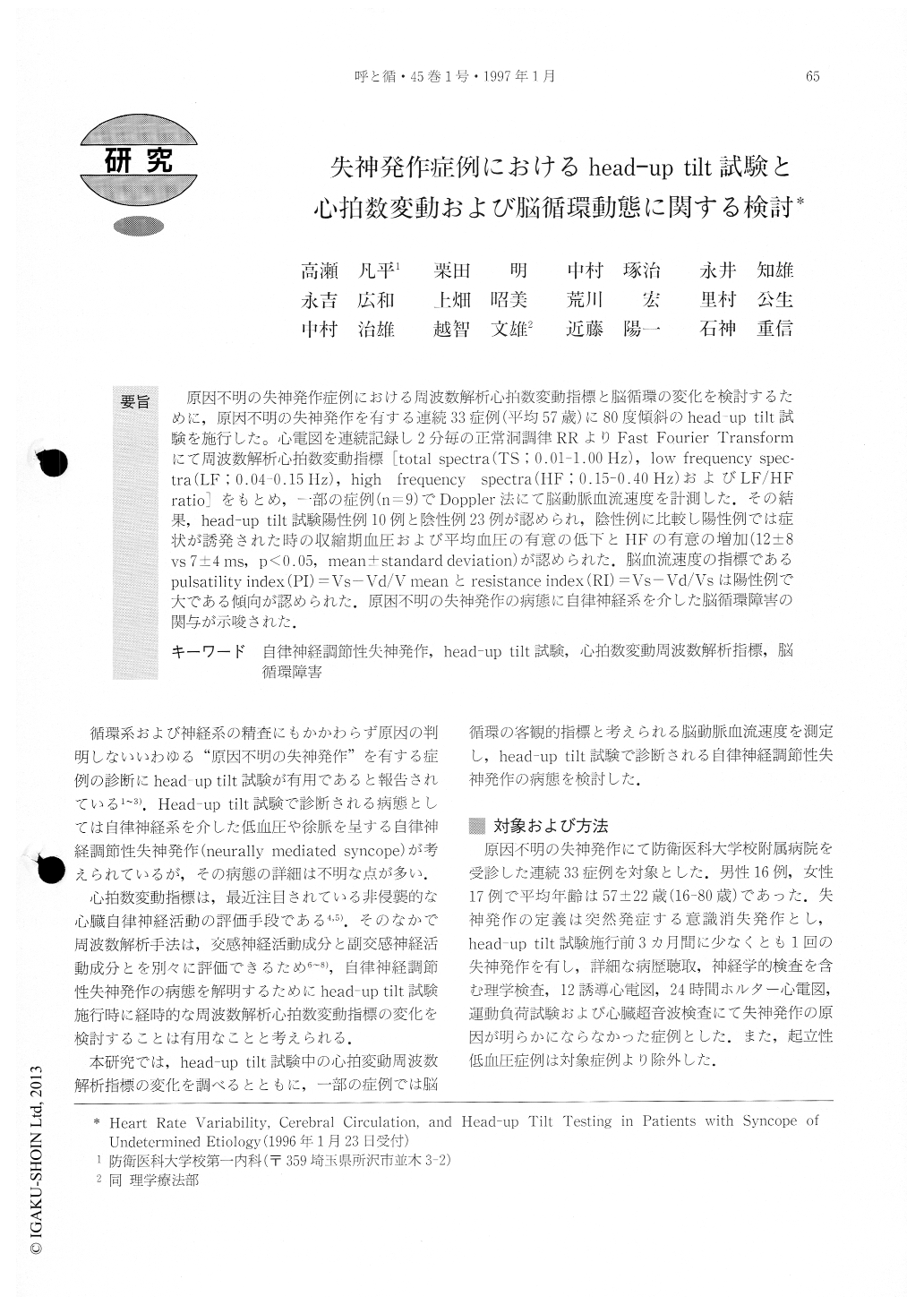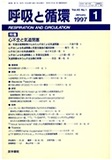Japanese
English
- 有料閲覧
- Abstract 文献概要
- 1ページ目 Look Inside
原因不明の失神発作症例における周波数解析心拍数変動指標と脳循環の変化を検討するために,原因不明の失神発作を有する連続33症例(平均57歳)に80度傾斜のhead-up tilt試験を施行した。心電図を連続記録し2分毎の正常洞調律RRよりFast Fourier Transformにて周波数解析心拍数変動指標[total spectra(TS;0.01-1.00 Hz),low frequency spec—tra(LF;0.04-0.15 Hz),high frequency spectra(HF;0.15-0.40 Hz)およびLF/HFratio]をもとめ,一部の症例(n=9)でDoppler法にて脳動脈血流速度を計測した.その結果,head-up tilt試験陽性例10例と陰性例23例が認められ,陰性例に比較し陽性例では症状が誘発された時の収縮期血圧および平均血圧の有意の低下とHFの有意の増加(12±8vs7±4ms,p<0.05,mean±standard deviation)が認められた.脳血流速度の指標であるpulsatility index(PI)=Vs-Vd/V meanとresistance index(RI)=Vs-Vd/Vsは陽性例で大である傾向が認められた.原困不明の失神発作の病態に自律神経系を介した脳循環障害の関与が示唆された.
To investigate the pathophysiology in neurally mediated syncope, we measured temporal changes of frequency domain heart rate variability indices and cerebral circulation using transcranial Doppler sonogra-phy during head-up tilt testing in patients with syncope of undetermined etiology.
Thirty three patients (16 men and 17 women: mean age 57±22 years) with unexplained syncope were evaluated by 80 degree head-up tilt testing for 40 minutes. Two-channel ambulatory electrocardiogram (CC5 and CM5 leads) recordings were obtained through-out a head-up tilt testing. Power spectral components of heart rate variability were calculated from ambulatory electrocardiogram recordings using Fast Fourier Trans-formation. Mean heart rate and power spectral compo-nents were measured in consecutive 2 minute periods throughout the study. Power spectrum consist of low frequency (0.04-0.15Hz), high frequency (0.15-0.40Hz) and total spectra (0.01-1.0Hz). A low frequency/high frequency spectra ratio which is suggested to represent relative sympathetic tone was derived. Transcranial Doppler sonography was used to evaluate middle cere-bral artery flow velocity in 9 patients. Systolic velocity (Vs), diastolic velocity (Vd), mean velocity (V mean), pulsatility index (PI=Vs-Vd/Vmean), and resistance index (RI=Vs-Vd/Vs) were obtained every one minute throughout the study.
Ten patients showed a positive and 23 patients a negative response. At the onset of the symptom, high frequency spectra increased significantly. Also positive response patients had significantly larger high frequency spectra values than those of negative response patients during head-up tilt testing (onset of symptom in posi-tive response vs. peak tilt in negative response, 12±8 vs. 7±4ms, p<0.05). Out of 9 patients, 3 patients showed a positive response and 6 patients a negative response. Percent changes of pulsatility index during symptom in positive response patients were significantly larger than those of negative response patients.
These findings suggest that increased vagal activity and impairment of cerebral circulation induced by head -up tilt testing have a significant role in the patho-genesis of neurally mediated syncope.

Copyright © 1997, Igaku-Shoin Ltd. All rights reserved.


